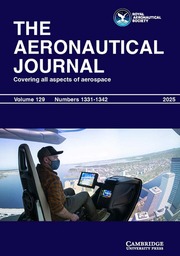Article contents
A note on the interpretation of mini-tuftphotographs
Published online by Cambridge University Press: 04 July 2016
Abstract
Although mini-tufts are considered generally to showthe surface flow direction on windswept surfaces,there is some uncertainty about their correctinterpretation, particularly as three-dimensionalflows approach separation. This note provides someguidance on this controversial question, based onexperience with mini-tufts on wings, fins andcanards in the DRA 13 ft x 9 ft low speedwind-tunnel at Bedford.
An illustration of the value of the technique is given.Mini-tuft photographs are used to identify thetrailing edge condition which relates to theclassification of the steady and fluctuationpressure distributions observed a swept wing with aconical, separated flow.
Information
- Type
- Research Article
- Information
- Copyright
- Copyright © Royal Aeronautical Society 1995
References
1.
Crowder, J.P.
Fluorescent mini-tufts for non-intrusive flow
visualisation, McDonnell Douglas Report MDC J7374,
1977.Google Scholar
2.
Dobney, D.G.,
Hanson, P.
and Fiddes, S.P.
The “mini-tuft” surface flow
visualisation method; experience of use in the RAE
5 m pressurised low-speed
windtunnel, Aeronaut
J, 1986,
90, (891), pp
10–17.Google Scholar
3.
Squire, L.C.
The motion of a thin oil sheet under
the steady boundary layer on a
body, J Fluid
Mech, 1961,
11, (2),
ppl61–179.Google Scholar
4.
Pitman, J.L.
Experimental flow field visualisation
of a high alpha wing at Mach 1·62,
J Aircraft, 1987,
24, (5), pp
335–341.Google Scholar
6.
Mabey, D.G.
A review of scale effects in unsteady
aerodynamics. Prog
Aerospace Sci, 1991,
28, (4), pp
273–321.Google Scholar
- 4
- Cited by

